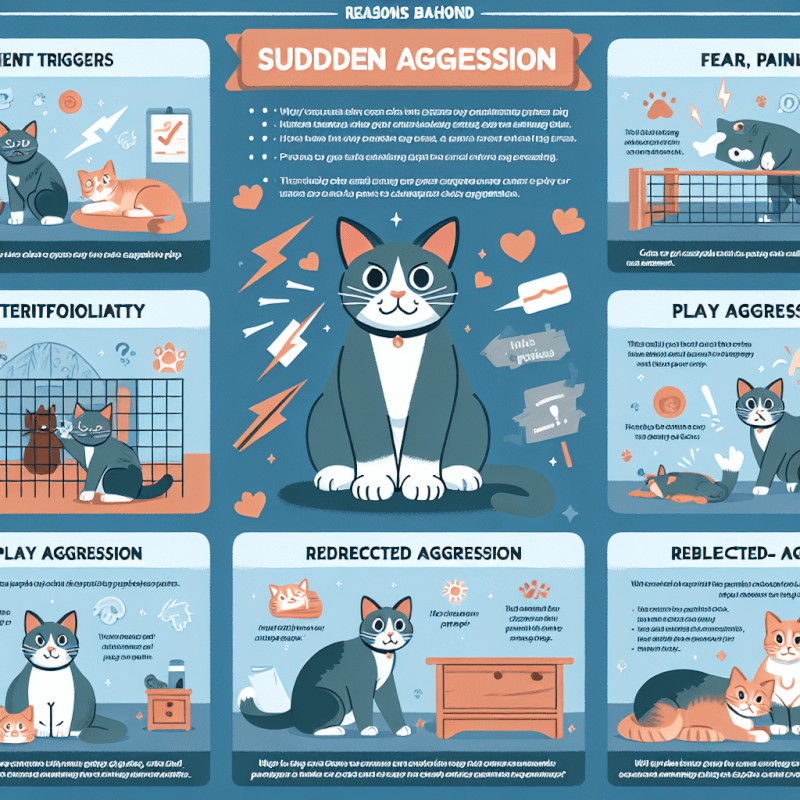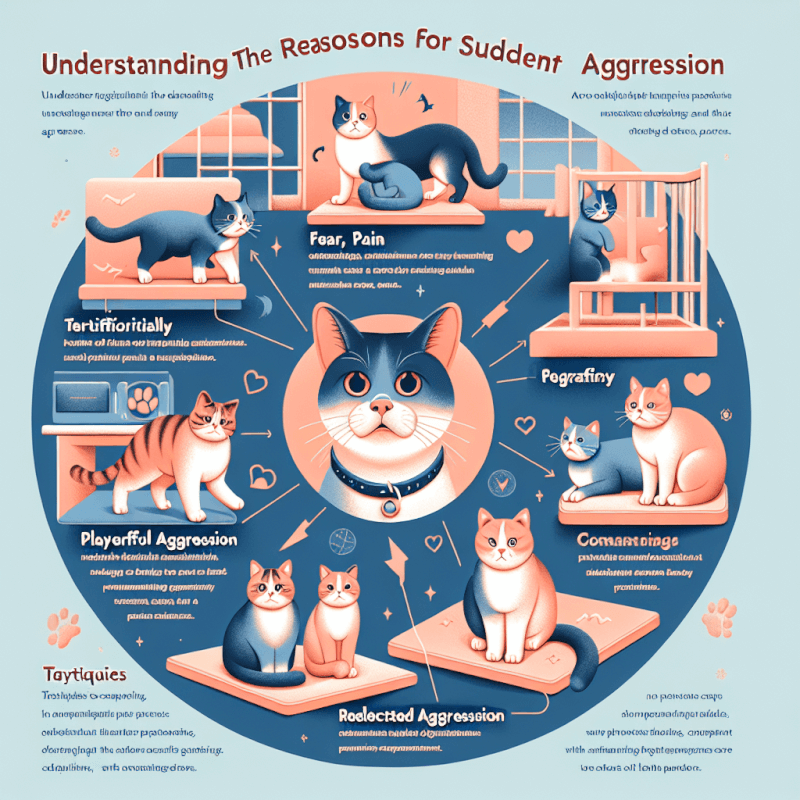If you’ve noticed a sudden change in your cat’s behavior and found yourself wondering, “Why is my cat suddenly acting aggressive?” you’re not alone. Cats are typically known for their calm and independent nature, so when aggression arises out of the blue, it can be concerning and confusing. In this article, we will explore some common reasons behind this behavior shift and provide insights on how to address and manage it effectively. So, if you’re ready to understand your furry friend’s newfound aggression and find ways to help them, let’s begin!
Understanding the Causes of Sudden Aggression
Aggression in cats can be a concerning behavior that may leave cat owners puzzled and worried. It’s important to understand the potential causes of sudden aggression in order to address them effectively and ensure the safety and well-being of your feline friend. Here are some common causes of sudden aggression in cats:
Ready for Cat Trivia?
Test your knowledge about cats!

Territorial or Resource Guarding
Cats are known to be territorial creatures, and sudden aggression can arise when they feel the need to defend their space or possessions. Territorial aggression may occur when a cat perceives its territory being invaded by another animal or even a human. Resource guarding, on the other hand, is when a cat becomes possessive and aggressive over certain items like food, toys, or even their favorite sleeping spot.
Fear or Stress
Fear and stress can trigger aggressive behavior in cats. Cats may feel threatened or frightened by various circumstances such as loud noises, unfamiliar people or animals, changes in their environment, or even traumatic experiences. When cats are fearful or stressed, they may lash out defensively, leading to sudden displays of aggression.
Medical Issues
Underlying medical issues can also contribute to sudden aggression in cats. Certain medical conditions, such as infections, injuries, dental problems, or hormonal imbalances, can cause a cat to experience pain, discomfort, or changes in behavior. It’s important to rule out any potential medical causes before addressing the aggression directly.
Provocation or Miscommunication
Miscommunication between cats or between a cat and its owner can sometimes lead to aggression. Cats have their unique ways of communicating, and misunderstanding these signals can cause tension and result in aggressive behavior. Provocation, whether intentional or unintentional, from humans or other animals, can also trigger aggression in cats.
Pain or Discomfort
Cats may exhibit sudden aggression if they are in pain or discomfort. Chronic pain, such as arthritis or dental issues, can make cats irritable and more prone to aggressive behavior. It’s essential to monitor for signs of pain and seek veterinary care to address underlying health problems.
Hormonal Changes
Hormonal changes, particularly during mating seasons or if a cat has not been spayed or neutered, can contribute to sudden aggression. Unaltered cats may become more territorial or assertive due to their reproductive instincts. Spaying or neutering your cat can help reduce hormonal influences and prevent aggressive behavior.
Detecting Behavioral Signs of Aggression
To effectively manage and address sudden aggression in cats, it’s essential to recognize the subtle behavioral signs that often precede aggressive behavior. By observing your cat’s body language and vocal cues, you can gain insight into their emotional state. Here are some common indications of aggression in cats:
Growling and Hissing
Growling and hissing are vocal signals that cats use to express aggression. When a cat growls or hisses, it’s a clear warning sign that they are feeling threatened or agitated. These vocalizations are often accompanied by other visual cues, such as raised fur, an arched back, and a stiff posture.
Swatting or Scratching
Swatting or scratching is a defensive response exhibited by aggressive cats. When a cat swats or scratches, it’s a way of asserting dominance or protecting themselves from perceived threats. It’s important to be cautious when interacting with a cat that displays this behavior to avoid getting injured.
Biting or Lunging
Biting and lunging are more severe manifestations of aggression in cats. These aggressive actions are usually provoked by fear, stress, or a perceived threat. Biting and lunging can occur suddenly and without warning, making it crucial to understand the underlying causes and take appropriate measures to prevent injuries.
Tail and Ear Positions
The position of a cat’s tail and ears can provide valuable information about their emotional state. When a cat’s tail is puffed up or held upright and rigid, it indicates aggression or fear. Similarly, if a cat’s ears are flattened, it can be a sign of arousal or aggression. Monitoring these visual cues can help identify potential triggers for aggression.
Dilated Pupils
Observing a cat’s pupils can give insights into their emotional state. Dilated pupils often indicate arousal or heightened alertness. While dilated pupils alone may not always suggest aggression, they can serve as a warning sign that a cat is becoming agitated or uncomfortable in a particular situation.
Understanding these behavioral signs can help you intervene early and implement appropriate measures to de-escalate aggression or prevent it from escalating further. By recognizing these cues, you can also address any underlying issues contributing to your cat’s aggression effectively.

Territorial or Resource Guarding
Defining territorial aggression
Territorial aggression in cats occurs when they feel the need to defend their space from perceived intruders. This behavior is instinctual, as cats are naturally inclined to establish and protect their territories. Signs of territorial aggression may include growling, hissing, swatting, and even biting when someone or something enters a cat’s perceived territory.
Identifying resource guarding
Resource guarding is another manifestation of aggression in cats, where they become possessive and defensive over their belongings or valuable resources. Cats may guard their food, toys, resting spots, or even their access to certain areas of the house. Resource guarding may be exhibited through aggressive behavior, such as growling, hissing, or biting, when someone approaches or tries to take away the guarded item.
Managing territorial or resource aggression
To address territorial or resource aggression in cats, it’s crucial to create a safe and comfortable environment that minimizes potential triggers. Providing separate spaces and resources for each cat in a multi-cat household can help reduce competition and minimize aggression. Ensuring an ample supply of resources, including food, water, litter boxes, and resting areas, can help alleviate resource-related conflicts.
Additionally, positive reinforcement training techniques can be employed to modify aggressive behaviors. Rewarding your cat for calm and non-aggressive behavior can help redirect their attention away from territorial or resource conflicts. Seeking the guidance of a professional animal behaviorist may also be beneficial in managing territorial or resource aggression in cats.
Fear or Stress
Recognizing signs of fear or stress
Fear and stress are significant contributors to feline aggression. Cats experiencing fear or stress may exhibit several behavioral signs, including hiding, excessive grooming, loss of appetite, dilated pupils, excessive vocalization, and changes in litter box habits. Aggressive behavior, such as growling, hissing, or scratching, can also arise when a cat feels threatened or overwhelmed.
Addressing fear or stress-related aggression
To address fear or stress-related aggression in cats, it’s important to identify the underlying causes and provide a safe and secure environment. Minimizing potential stressors, such as loud noises or sudden changes in routine, can help create a calmer atmosphere for your cat.
Establishing predictable routines, providing hiding spots or elevated perches, and offering interactive toys and mental stimulation can also help alleviate fear or stress. Additionally, pheromone-based products, such as Feliway, can create a calming environment and reduce stress-related aggression.
Gradual desensitization and counterconditioning techniques, under the guidance of a professional behaviorist, can help cats overcome their fear or anxiety triggers. These methods involve gradually exposing the cat to the fear-inducing stimulus, while providing positive reinforcements and rewards for calm behavior.
Additionally, veterinary consultation may be necessary to assess the need for anti-anxiety medications or supplements that can help manage fear or stress-related aggression in cats.

Medical Issues
Common medical conditions that can cause aggression
Various medical conditions can contribute to sudden aggression in cats. Pain or discomfort resulting from infections, injuries, dental problems, or chronic illnesses can manifest as aggressive behavior. Neurological disorders, cognitive decline, and hormonal imbalances can also impact a cat’s behavior and potentially lead to aggression.
Obtaining a veterinary evaluation
If your cat is displaying sudden aggression, it’s crucial to seek veterinary evaluation to rule out any underlying medical causes. A thorough examination and appropriate diagnostic tests can help identify potential health issues that may be contributing to the aggressive behavior. Your vet will also consider the cat’s medical history and behaviors to establish an accurate diagnosis.
Treating aggression caused by medical issues
Treating aggression caused by medical issues involves addressing the underlying health problem. Depending on the diagnosis, treatment may include medications to alleviate pain or discomfort, antibiotics for infections, or specialized diets for specific conditions. Surgical interventions, such as spaying or neutering, may also be recommended to address hormonal influences on behavior.
In some cases, behavioral modifications and management strategies may be necessary to prevent or redirect aggressive behavior while the medical issue is being addressed. Collaborating with your veterinarian and a professional animal behaviorist can help develop a comprehensive treatment plan that addresses both the medical and behavioral aspects of aggression.
Provocation or Miscommunication
Understanding feline social dynamics
Cats are complex animals with unique social dynamics. Understanding their social structure is crucial for preventing provocation or miscommunication that can lead to aggression. Cats are naturally solitary animals, and their social interactions are primarily based on territorial boundaries and resource availability.
While some cats may form close bonds with humans or other animals, many prefer their personal space and independent lifestyle. Respecting a cat’s boundaries and providing them with the freedom to engage in social interactions on their terms can help prevent aggression resulting from provocation or miscommunication.
Identifying triggers for provocation
To prevent provocation or miscommunication-induced aggression, it’s important to identify the triggers that may lead to these behaviors. This can include situations where a cat feels cornered, forced into close proximity with other animals, or exposed to unfamiliar or threatening stimuli. Understanding your cat’s sensitivities and carefully managing their interactions can help reduce the likelihood of aggressive responses.
Improving communication with your cat
Improving communication with your cat is essential in mitigating aggression resulting from provocation or miscommunication. This involves observing and respecting your cat’s behavioral cues, such as body language and vocalizations. Avoid forcing interactions or invading their personal space when they demonstrate signs of discomfort or stress.
Positive reinforcement training techniques can also be employed to establish clearer communication with your cat. Rewarding desirable behaviors and providing distractions or alternatives in situations that may lead to aggression can help redirect their focus and prevent potential conflicts.
By establishing a mutually understanding and respectful relationship with your cat, you can minimize the risk of provocation-induced aggression and create a harmonious environment.

Pain or Discomfort
Recognizing signs of pain or discomfort
Pain or discomfort can significantly impact a cat’s behavior and potentially lead to sudden aggression. Cats may be adept at hiding signs of pain, but subtle behavioral changes can indicate underlying discomfort. These changes may include decreased appetite, decreased grooming, restlessness, vocalization, and changes in social interactions. Increased sensitivity or aversion to touch and aggression can also be signs of pain.
Seeking veterinary care for possible pain-related aggression
If your cat is displaying signs of aggression, especially when it appears to be associated with pain or discomfort, it’s crucial to seek veterinary care promptly. A comprehensive examination, including a discussion of the cat’s medical history and behavior changes, will help the veterinarian evaluate possible underlying causes.
Diagnostic tests, such as X-rays or blood work, may be necessary to identify specific medical issues causing pain or discomfort. Once a diagnosis is established, appropriate treatment options, such as pain medications, anti-inflammatory drugs, or physical therapy, can be implemented to alleviate the discomfort and reduce aggression.
Hormonal Changes
Understanding hormonal influences on behavior
Hormonal changes can significantly impact a cat’s behavior, especially if they have not been spayed or neutered. Unaltered cats may display more assertive or aggressive behavior due to their reproductive instincts. Mating seasons or the presence of other unaltered cats in the vicinity can trigger heightened territorial behavior and aggression.
Spaying or neutering your cat can help regulate hormonal influences and reduce the likelihood of aggression associated with reproductive instincts. This procedure typically minimizes territorial marking, reduces the desire to roam, and diminishes aggressive behaviors related to mating.
Addressing aggression related to hormonal changes
Addressing aggression related to hormonal changes often involves spaying or neutering the cat. Consulting with your veterinarian about the appropriate time and method for the procedure is advised. In some cases, spaying or neutering alone may not completely eliminate aggressive behaviors, especially if other underlying factors are contributing to the aggression.
Implementing behavior modification techniques, such as positive reinforcement training or environmental enrichment, can further assist in managing aggression associated with hormonal changes. Consistency and patience are essential when working with hormonal-related aggression.
By addressing hormonal influences on behavior and providing appropriate training and management strategies, you can help ensure a calmer and more harmonious relationship with your cat.

Growling and Hissing
Interpreting vocal cues of aggression
Growling and hissing are vocal cues commonly associated with aggression in cats. These sounds serve as warnings to potential threats or perceived invaders of their territory. When a cat growls or hisses, it’s essential to respect their boundaries and give them space.
Interpreting vocal cues of aggression involves understanding the context in which they occur. If a cat growls or hisses when approached or in response to specific stimuli, it’s crucial to identify and address the underlying triggers to prevent potential conflicts.
Responding to growling and hissing
When a cat growls or hisses, it’s best to give them space and avoid any potential confrontation. Pushing or forcing interaction can escalate their aggression and potentially lead to injury.
Instead, create a calm and safe environment for the cat, removing any triggers or threats that may have elicited the vocalization. Offering an escape route or a secure hiding spot can help the cat feel more in control and reduce the need for aggressive displays.
If the aggression persists or escalates, consult with a veterinary behaviorist for professional guidance. They can provide specific strategies and behavior modification techniques tailored to your cat’s needs.
Dilated Pupils
Understanding the significance of dilated pupils
Dilated pupils in cats often indicate an increased arousal state or heightened alertness. While dilated pupils alone may not always signify aggression, they can accompany other aggressive behaviors. Dilated pupils can occur in response to fear, stress, excitement, or even during play.
Observing a cat’s dilated pupils can help identify their emotional state and potential triggers for aggression. Monitoring their pupils alongside other behavioral cues, such as vocalizations or body language, can provide a more comprehensive understanding of their emotional state.
Addressing aggression associated with dilated pupils
If a cat displays aggression alongside dilated pupils, it’s vital to address the underlying cause of their heightened arousal. Assess the situation and identify potential triggers that may have led to the aggressive behavior.
Providing a calm and stress-free environment can help alleviate tension and reduce the likelihood of aggression. Implementing behavior modification techniques, such as positive reinforcement training or desensitization, can assist in redirecting the cat’s focus away from aggressive responses.
Seeking guidance from a professional behaviorist or consulting with your veterinarian can provide additional insight and strategies for managing aggression associated with dilated pupils.
In conclusion, sudden aggression in cats can be caused by various factors, including territorial or resource guarding, fear or stress, medical issues, provocation or miscommunication, pain or discomfort, and hormonal changes. It is essential to detect the behavioral signs of aggression, such as growling, hissing, swatting, biting, and dilated pupils, in order to intervene effectively. Understanding the causes and employing appropriate management strategies, including behavioral modifications and veterinary care, will help address sudden aggression and establish a harmonious relationship with your feline companion. Remember, seeking professional help and guidance when dealing with aggression is always recommended to ensure the safety and well-being of both you and your cat.



